In 1994, the Israeli military responded to a massacre by a Jewish settler by restricting the movement of Hebron’s Palestinian residents. Two decades later, the restrictions are more severe and some of Israel’s most extreme settlements continue to grow in the heart of the West Bank’s largest city.
Photos by: Anne Paq, Ryan Rodrick Beiler, Yotam Ronen, and Oren Ziv/Activestills.org

An Israeli settlement water tank stands near the Ibrahimi Mosque or Tomb of the Patriarchs in the West Bank city of Hebron. All settlements in the occupied Palestinian territories are illegal under international law.
Twenty years ago, on February 25, 1994, American-born doctor and Israeli settler Baruch Goldstein walked into Hebron’s al-Ibrahimi Mosque and opened fire with his military issued rifle, killing 29 Palestinian worshippers and injuring 125. Goldstein himself was eventually overcome and beaten to death.
In protests that followed the massacre, another 25 Palestinians were killed by Israeli forces. Five Israelis died in the violence.
Rather than removing volatile settlements embedded in the heart one of the largest Palestinian cities, the Israeli military’s response was a policy of separation between settlers and Palestinians on Hebron’s streets. The result is a network of heavily guarded enclaves whose presence punishes Palestinian neighbors with a matrix of checkpoints and restricted areas.
Hebron’s Shuhada Street has seen the most notorious of these restrictions. Once a busy commercial center, many shop doors have now been welded shut by military order, giving the area the appearance of a ghost town.

In some sections of the street, Palestinians are barred from driving while Israeli cars enter freely. In others, Palestinians are completely banned from entering. Some Palestinian families must enter their homes by alleys, ladders and back doors because their front doors on Shuhada Street are off limits.
On one stretch of street near the Ibrahimi Mosque/Tomb of the Patriarchs, a low concrete barrier once segregated Palestinian foot traffic from Israeli cars and pedestrians. Highly visible to international tourists visiting the holy site, the barrier has since been removed, while the military installed another barrier for the same purpose — this one topped with a wire mesh fence — on an adjacent street less visible to visitors.
Due to the intensity of its occupation regime, Hebron remains the focus of annual protests to open Shuhada Street, and is a frequent flashpoint for clashes between the Israeli military, Palestinians and settlers in general.
However, for centuries, a small Arabic-speaking Jewish community had lived at peace with its neighbors in Hebron, with whom they shared many cultural ties. It was not until the influx of European Jews arrived at the turn of the 20th century that tensions rose, especially following the Balfour Declaration. These tensions boiled over in August 1929, as violence spread from Jerusalem following a Jewish nationalist march on the Western Wall. Though hundreds of Hebron’s Jews were protected by their Muslim neighbors, 67 were killed in riots fueled by false rumors that Muslims were being massacred in Jerusalem.
Though Hebron’s contemporary settlers purport to be reclaiming areas that were Jewish prior to the 1929 violence, most of them are once again foreigners (including many Americans) with little connection to the original owners. Their ideological agenda sharply contrasts with the generally good relations enjoyed by Jews who lived in Palestine before the Zionist movement. These settlers continue to expand their presence in Hebron by taking over more Palestinian homes and properties, often through fraudulent means accompanied by violent harassment. Though ownership of several such properties in Hebron is currently under deliberation by Israeli courts, all settlements in occupied Palestinian territory are illegal under international law.
In the midst of this climate of violence and harassment, the military frequently ignores or actively protects settlers who attack Palestinians or vandalize their property. As Hebron settler spokesman David Wilder told a documentary filmmaker, “Blessed God says, ‘Make war for this land, conquer this land.’ So this is what I do.”

Relatives of Palestinians killed at the Ibrahimi Mosque in 1994 hold a candlelight vigil in the West Bank city of Hebron to mark the 15th anniversary since U.S.-born Israeli settler Baruch Goldstein opened fire on worshipers, killing 29 people and wounding another 125, February 25, 2009.

An elderly Palestinian man passes through an Israeli checkpoint in the center of Hebron’s old city.

Israeli settler children take part in the traditional Purim holiday parade taking place on Shuhada Street, as Palestinian children, whose access to the street is severely restricted, look from a balcony above, Hebron, West Bank, February 24, 2013.

A Palestinian youth balances atop the concrete barrier segregating Israeli and Palestinian traffic on a section of Hebron’s Shuhada Street. The barrier on this section of street has since been removed.

Israeli soldiers place a new concrete and steel barrier to segregate Palestinian pedestrians from Israeli traffic along a road in the H2 section of Hebron, October 22, 2013. The road connects the Ibrahimi Mosque (Tomb of the Patriarchs) in Hebron’s old city with the nearby Israeli settletment Kiryat Arba. Israelis are allowed to drive on the road, but Palestinians are prohibited from driving there without special permission, which few are able to obtain.
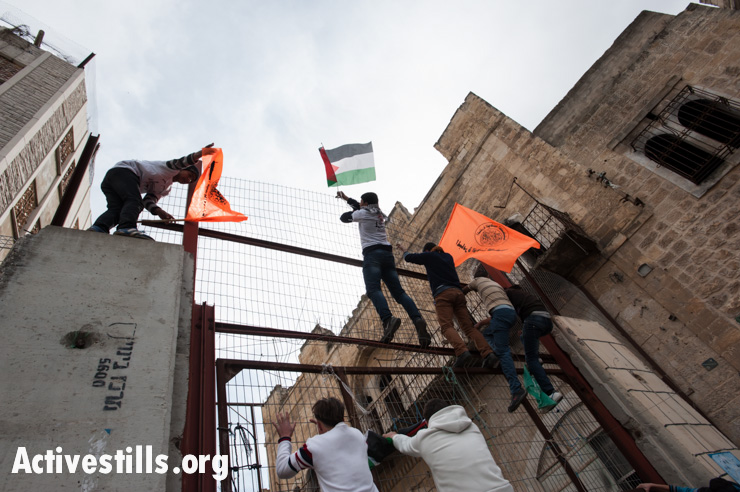
Demonstrators climb a steel and concrete barrier blocking access to Hebron’s Shuhada Street during a protest against the closure of the street to Palestinians, February 22, 2013. Hundreds of demonstrators, including foreign and Israeli activists, gathered to mark the 19th anniversary of the massacre by Baruch Goldstein.
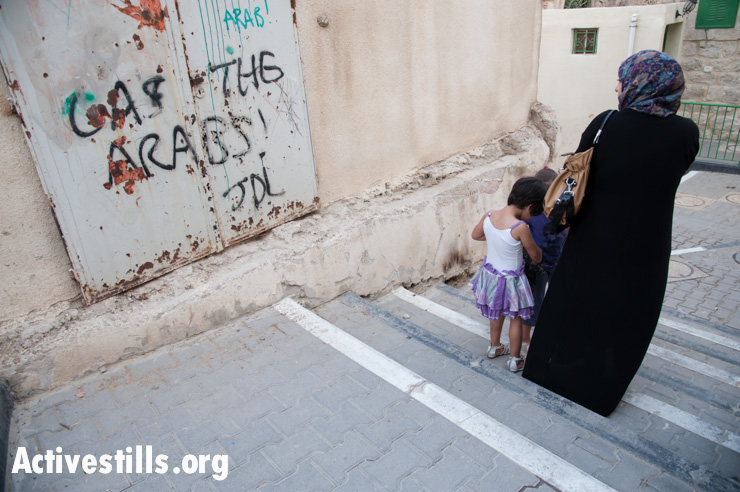
A Palestinian woman and children pass the slogan “Gas the Arabs! JDL” spray-painted on an exterior wall of the Cordoba School for Palestinian children near Shuhada Street, Hebron, October 22, 2012. “JDL” stands for Jewish Defense League, an extremist group founded by Meir Kahane and designated as a terrorist group by the FBI. Baruch Goldstein was a charter member of the JDL, which has designated him “a martyr in Judaism’s protracted struggle against Arab terrorism.”

An Israeli settler harasses a group of women activists wearing traditional Palestinian dress who are walking down Shuhada Street as part of an action to protest against the closure of the street to Palestinians in the West Bank city of Hebron, June 13, 2012. The women were stopped after a few meters by the Israeli army and harassed by settlers. Six activists were arrested.

A girl plays as a Palestinian man harvests his olive trees in the Tel Rumeida neighborhood in the West Bank city of Hebron, October 24, 2013.

Israeli settlers attack a photographer during an olive harvest activity in Hebron. The people of Hebron are frequently harassed and physically attacked by settlers on their agricultural lands. During the olive harvest, international and Israeli activists often join the villagers to harvest the olive crop.

Palestinian children look through a window in their house near the Israeli settlement of Tel Rumeida in the West Bank city of Hebron. Their home has been attacked by settlers on numerous occasions.

Palestinians unload a donkey cart loaded with sacks of ingredients for use in a sweets shop in the H2 section of Hebron, October 22, 2013. The workers must use a donkey cart because Israelis are allowed to drive on the road accessing the shop, but Palestinians are prohibited from driving cars there without special permission, which few are able to obtain. The road connects the Ibrahimi Mosque (Tomb of the Patriarchs) in Hebron’s old city with the nearby Israeli settlement Kiryat Arba.

Nets affixed above the streets of Hebron’s old city protect Palestinian pedestrians from trash thrown by Israeli settlers living in apartments they occupy above.
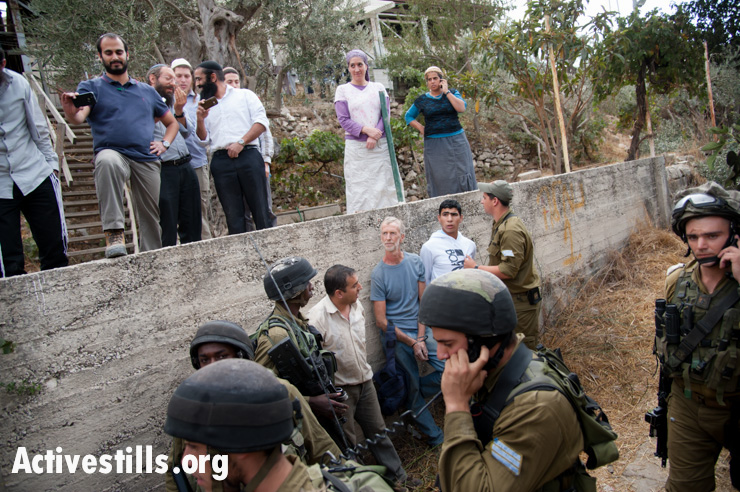
With Israelis from Tel Rumeida settlement looking on from above, Israeli soldiers arrest two Palestinians and an international volunteer after confrontations between settlers, a Palestinian family who had just harvested their olives, and the military, October 22, 2012. The arrests followed the first time the family was able to harvest their olives since 2007. Despite Israeli court confirmation of the family’s ownership of the grove, their harvest was disrupted by settlers, after which soldiers ordered the family to leave their trees.

Tourists take photos with Israeli soldiers in Hebron, West Bank, November 1, 2012.

“Palestine” was added (and then obscured by Stars of David) on a graffiti reading “Free Israel” in the Tel Rumeida neighborhood of the old city of Hebron, West Bank, October 4, 2012. A group of artists came to Hebron to paint graffiti in support of the Israeli settlers. Some of their work was then modified by pro-Palestinian activists, which settlers then attempted to cover up.
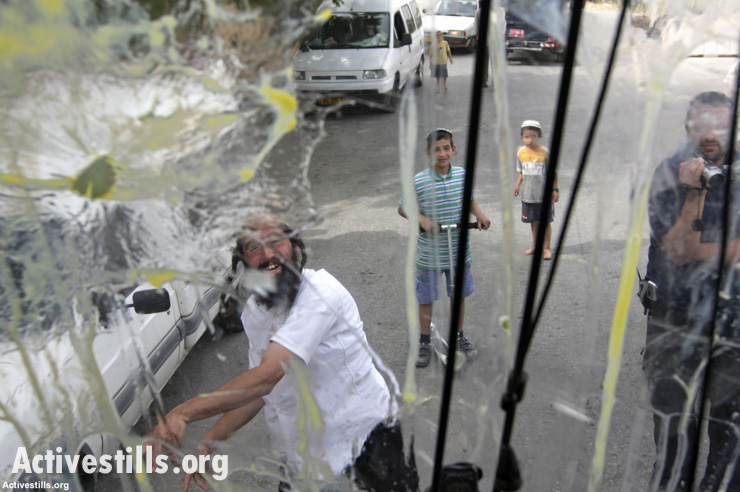
Israeli settlers attack a Palestinian home in Hebron, April 25, 2008.
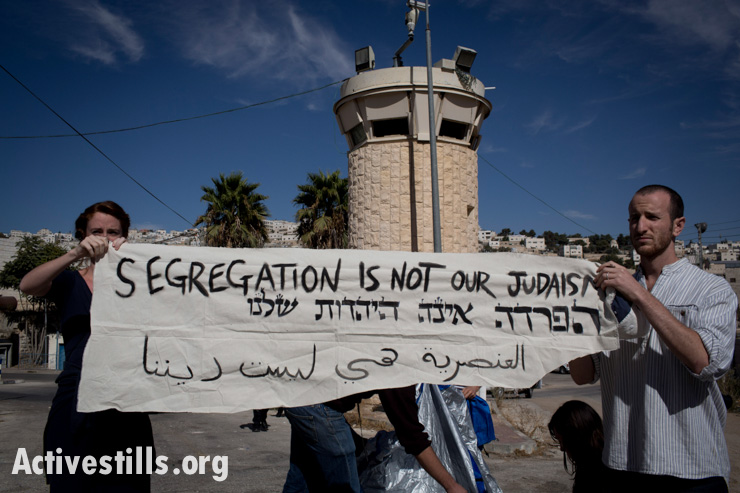
Jewish activists protest the segregation of Shuhada Street in the West Bank city of Hebron, October 25, 2013. Seven activists were taken to the Hebron police station and charged with violating a closed military zone order. The activists, from a group called All That’s Left, went to Hebron on the eve of Shabbat Chayei Sarah, which is when the Torah portion of the same name is read. Religious-nationalist Jews descend on Hebron over the weekend to mark the text they believe to be proof that Jews own Hebron.

Israeli settler Itamar Ben Gvir (right), dressed as a Palestinian prisoner, marches in a parade celebrating the Jewish holiday of Purim on Shuhada Street, heavily guarded by Israeli police and military forces, Hebron, West Bank, February 24, 2013.

A demonstrator wearing a Martin Luther King Jr. mask is arrested on Shuhada Street by an Israeli soldier during a demonstration against the planned visit of U.S. President Barak Obama to the West Bank, Hebron, March 20, 2013.

An Israeli soldier escorts a group of settlers during a tour of Hebron’s old city, February 20, 2010. Settlers have started to tour the old city of Hebron every Saturday in recent years. In addition to a military escort, many of the settlers are armed. In the process, they disrupt the lives of Palestinians, often harassing them on the way.

International observers film a settler during a protest calling for the opening of Shuhada Street, in Hebron, February 25, 2010. Activists with various international human rights organizations provide protective presence by accompanying Palestinians who face violence from settlers and soldiers.
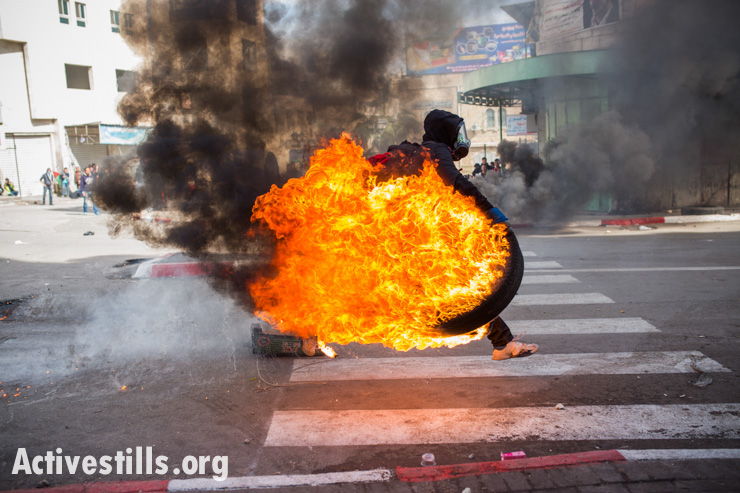
A Palestinian youth rolls a burning tire during a protest against the closure of the Shuhada Street to Palestinians in the West Bank city of Hebron February 21, 2014. Some 500 protesters, including foreign and Israeli activists, gathered to mark the 20th anniversary of the closure of the street.

A Jewish visitor to the tomb of Abraham is visible through a bulletproof glass barrier in the Al-Ibrahimi Mosque or Tomb of the Patriarchs in the West Bank city of Hebron. The chamber housing Abraham’s cenotaph is visible from either side of the building, which is segregated between Jewish and Muslim sections.
Related:
In Hebron, terror begets a reign of terror
Subscribe to The Landline
+972's weekly newsletter



























